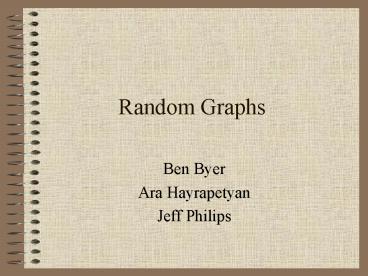Random Graphs - PowerPoint PPT Presentation
1 / 13
Title:
Random Graphs
Description:
What is a graph? Collection of vertices and edges, or points and adjacencies ... chromatic number - (G) - the smallest number of colors needed to color every ... – PowerPoint PPT presentation
Number of Views:57
Avg rating:3.0/5.0
Title: Random Graphs
1
Random Graphs
- Ben Byer
- Ara Hayrapetyan
- Jeff Philips
2
Graph background
- What is a graph?
- Collection of vertices and edges, or points and
adjacencies - We will discuss a graph G
3
Common permutations of graphs
- Subgraph vertices and edges removed
- Induced subgraph only vertices removed
4
More permutations
- Complement graph invert the existence of edges
5
Notation
- n(g) number of vertices in graph g
- e(g) number of edges in graph g
6
Common functions of graphs
- girth - g(G) - the length of the shortest simple
cycle in a graph - chromatic number - ?(G) - the smallest number of
colors needed to color every vertex, so that no
two adjacent vertices share the same color. - diameter - d(G) - the length of the longest path
in the set of shortest paths between every pair
in a graph
7
More functions
- clique number - ?(G) - the size (in vertices) of
the largest clique in a graph - independence number - ?(G) - the size(in
vertices) of the largest set of non-connected
nodes in a graph - k-connected - two vertices are k-connected if
they are mutually adjacent to k other vertices.
(A graph is k-connected if every pair of vertices
is k-connected.)
8
n(G)
- n(G) ? ?(G) ?(G)
- Proof
- graph will have ?(G) independent subgraphs, one
per color - each of these independent subgraphs is no larger
than ?(G) (a given colors set is independent by
definition)
9
What is a random graph?
- Vertex definition - n vertices, p probability of
each edge - Edge definition - n vertices, m edges
- Theyre equivalent - we will use vertex
definition - G(n,p) set of all random graphs with parameters
n and p
10
Properties of all graphs
- Isomorphism Two graphs are isomorphic if a
mapping exists between the vertices of the graph,
such that the edges are preserved - Property (on a graph) A quality of a graph that
is true for all isomorphic graphs
11
Why random graphs?
- Used to prove existence of graphs with specific
properties - Example Erdos
- Exist graphs with arbitrarily large ?(G) and g(G)
12
Almost all graphs
- Property P holds for almost all graphs if the
probability that it holds for some G tends to 1,
as n??
13
Application melting point
- Model of matter as a random, connected graph
- Largely connected solid as bonds break, state
changes - Actual structure does not matter, only rough
arrangement and connectedness - Exist thresholds, analogous to edge
probabilities, at which these states change































